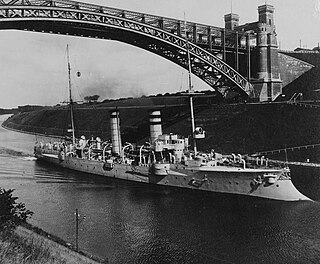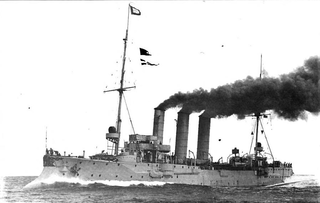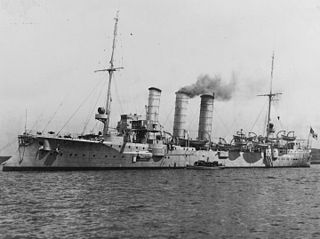
The Battle of Heligoland Bight was the first Anglo-German naval battle of the First World War, fought on 28 August 1914, between ships of the United Kingdom and Germany. The battle took place in the south-eastern North Sea, when the British attacked German patrols off the north-west German coast. The German High Seas Fleet was in harbour on the north German coast while the British Grand Fleet was out in the northern North Sea. Both sides engaged in long-distance sorties with cruisers and battlecruisers, with close reconnaissance of the area of sea near the German coast—the Heligoland Bight—by destroyer.

SMS Moltke was the lead ship of the Moltke-class battlecruisers of the German Imperial Navy, named after the 19th-century German Field Marshal Helmuth von Moltke. Commissioned on 30 September 1911, the ship was the second battlecruiser of the Imperial Navy. Moltke, along with her sister ship Goeben, was an enlarged version of the previous German battlecruiser design, Von der Tann, with increased armor protection and two more main guns in an additional turret. Compared to her British rivals—the Indefatigable class—Moltke and her sister Goeben were significantly larger and better armored.

SMS Pommern was one of five Deutschland-class pre-dreadnought battleships built for the Kaiserliche Marine between 1904 and 1906. Named after the Prussian province of Pomerania, she was built at the AG Vulcan yard at Stettin, Germany, where she was laid down on 22 March 1904 and launched on 2 December 1905. She was commissioned into the navy on 6 August 1907. The ship was armed with a battery of four 28 cm (11 in) guns and had a top speed of 18 knots. The ships of her class were already outdated by the time they entered the service, being inferior in size, armor, firepower, and speed to the revolutionary new battleship HMS Dreadnought.

SMS Cöln was a Kolberg-class light cruiser of the German Kaiserliche Marine during the First World War. She had three sister ships, SMS Kolberg, Mainz, and Augsburg. She was built by the Germaniawerft in Kiel; her hull was laid down in 1908 and she was launched in June 1909. Cöln was commissioned into the High Seas Fleet in June 1911. She was armed with a main battery of twelve 10.5 cm SK L/45 guns and had a top speed of 25.5 kn. After her commissioning, she served with the II Scouting Group, part of the reconnaissance forces of the High Seas Fleet.

SMS Pillau was a light cruiser of the Imperial German Navy. The ship, originally ordered in 1913 by the Russian navy under the name Maraviev Amurskyy, was launched in April 1914 at the Schichau-Werke shipyard in Danzig. However, due to the outbreak of World War I in August 1914, the incomplete ship was confiscated by Germany and renamed SMS Pillau for the East Prussian port of Pillau. Pillau was commissioned into the German Navy in December 1914. She was armed with a main battery of eight 15 cm SK L/45 (5.9-inch) guns and had a top speed of 27.5 kn. One sister ship was built, Elbing.

SMS Frauenlob was the eighth member of the ten-ship Gazelle class of light cruisers that were built for the German Kaiserliche Marine in the late 1890s and early 1900s. The Gazelle class was the culmination of earlier unprotected cruiser and aviso designs, combining the best aspects of both types in what became the progenitor of all future light cruisers of the Imperial fleet. Built to be able to serve with the main German fleet and as a colonial cruiser, she was armed with a battery of ten 10.5 cm (4.1 in) guns and a top speed of 21.5 knots. Frauenlob was a modified version of the basic Gazelle design, with improved armor and additional coal storage for a longer cruising range.

SMS Frankfurt was a light cruiser of the Wiesbaden class built by the German Kaiserliche Marine. She had one sister ship, SMS Wiesbaden; the ships were very similar to the previous Karlsruhe-class cruisers. The ship was laid down in 1913, launched in March 1915, and completed by August 1915. Armed with eight 15 cm SK L/45 guns, Frankfurt had a top speed of 27.5 knots and displaced 6,601 t at full load.

SMS Stralsund was a Magdeburg-class light cruiser of the German Kaiserliche Marine. Her class included three other ships: Magdeburg, Breslau, and Strassburg. She was built at the AG Weser shipyard in Bremen from 1910 to December 1912, when she was commissioned into the High Seas Fleet. The ship was armed with a main battery of twelve 10.5 cm SK L/45 guns and had a top speed of 27.5 knots.

SMS Strassburg was a light cruiser of the Magdeburg class in the German Kaiserliche Marine. Her class included three other ships: Magdeburg, Breslau, and Stralsund. Strassburg was built at the Kaiserliche Werft shipyard in Wilhelmshaven from 1910 to October 1912, when she was commissioned into the High Seas Fleet. The ship was armed with a main battery of twelve 10.5 cm (4.1 in) SK L/45 guns and had a top speed of 27.5 knots.

SMS Stettin was a Königsberg-class light cruiser of the Kaiserliche Marine. She had three sister ships: Königsberg, Nürnberg, and Stuttgart. Laid down at AG Vulcan Stettin shipyard in 1906, Stettin was launched in March 1907 and commissioned into the High Seas Fleet seven months later in October. Like her sisters, Stettin was armed with a main battery of ten 10.5 cm (4.1 in) guns and a pair of 45 cm (18 in) torpedo tubes, and was capable of a top speed in excess of 25 knots.

SMS Wettin was a pre-dreadnought battleship of the Wittelsbach class of the German Kaiserliche Marine. She was built by Schichau Seebeckwerft in Danzig. Wettin was laid down in October 1899, and was completed October 1902. She and her sister ships—Wittelsbach, Zähringen, Schwaben and Mecklenburg—were the first capital ships built under the Navy Law of 1898. Wettin was armed with a main battery of four 24 cm (9.4 in) guns and had a top speed of 18 knots.

SMS Königsberg was the lead ship of the Königsberg class of light cruisers, built for the German Kaiserliche Marine during World War I. She took the name of the earlier Königsberg, which had been destroyed during the Battle of Rufiji Delta in 1915. The new ship was laid down in 1914 at the AG Weser shipyard, launched in December 1915, and commissioned into the High Seas Fleet in August 1916. Armed with eight 15 cm SK L/45 guns, the ship had a top speed of 27.5 kn.

SMS Regensburg was a light cruiser of the Graudenz class built by the German Kaiserliche Marine. She had one sister ship, SMS Graudenz. The ship was built by the AG Weser shipyard in Bremen, laid down in 1912, launched in April 1914, and commissioned into active service in January 1915. She was named for the German town of Regensburg. The ship was armed with a main battery of twelve 10.5 cm SK L/45 guns and had a top speed of 27.5 knots, though in 1917 she was rearmed with seven 15 cm SK L/45 guns.

SMS Danzig was a light cruiser of the Imperial German Navy. Named for the city of Danzig, she was the seventh and last ship of the Bremen class. She was begun by the Imperial Dockyard in her namesake city in 1904, launched on 23 September 1905 and commissioned on 1 December 1907. Armed with a main battery of ten 10.5 cm (4.1 in) guns and two 45 cm (18 in) torpedo tubes, Danzig was capable of a top speed of 22 knots.

SMS Hamburg was the second member of the seven-vessel Bremen class of light cruisers, built for the German Kaiserliche Marine in the early 1900s. She and her sister ships were ordered under the 1898 Naval Law that required new cruisers be built to replace obsolete vessels in the fleet. The design for the Bremen class was derived from the preceding Gazelle class, utilizing a larger hull that allowed for additional boilers that increased speed. Named for the city of Hamburg, the ship was armed with a main battery of ten 10.5 cm (4.1 in) guns and had a top speed of 22 knots.

SMS Lübeck was the fourth of seven Bremen-class cruisers of the Imperial German Navy, named after the city of Lübeck. She was begun by AG Vulcan Stettin in Stettin in 1903, launched in March 1904 and commissioned in April 1905. Armed with a main battery of ten 10.5 cm (4.1 in) guns and two 45 cm (18 in) torpedo tubes, Lübeck was capable of a top speed of 22.5 knots.

SMS München was the fifth of seven Bremen-class cruisers of the Imperial German Navy, named after the city of Munich. She was built by AG Weser in Bremen, starting in 1903, launched in April 1904, and commissioned in January 1905. Armed with a main battery of ten 10.5 cm (4.1 in) guns and two 45 cm (18 in) torpedo tubes, München was capable of a top speed of 22.5 knots.
SMS Stuttgart was a Königsberg-class light cruiser of the Kaiserliche Marine, named after the city of Stuttgart. She had three sister ships: Königsberg, Nürnberg, and Stettin. Stuttgart was laid down at the Imperial Dockyard in Danzig in 1905, launched in September 1906, and commissioned in February 1908. Like her sisters, Stettin was armed with a main battery of ten 10.5 cm (4.1 in) guns and a pair of 45 cm (18 in) torpedo tubes, and was capable of a top speed in excess of 25 knots.

SMS V190 was a S-138-class large torpedo boat of the Imperial German Navy. She was built by the AG Vulcan shipyard at Stettin between 1910 and 1911, completing on 5 August 1911.

SMS Preussischer Adler was a paddle steamer originally built in the mid-1840s for use on a packet route between the Kingdom of Prussia and the Russian Empire in the Baltic Sea. She was requisitioned by the Prussian Navy during the First Schleswig War in 1848 and converted into an aviso, the first vessel of the type commissioned by Prussia. During the war, she took part in an inconclusive action with the Danish brig St. Croix, the first naval battle of the Prussian fleet. After the war, she was disarmed and returned to her commercial role, operating uneventfully on the Stettin–St. Petersburg route until 1862, when the expansion of the Prussian Eastern Railway had rendered the maritime route superfluous. The ship was purchased by the Prussian Navy that year and rearmed, once again as an aviso.




























